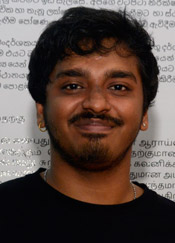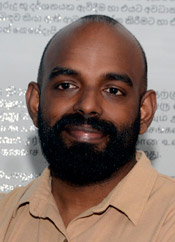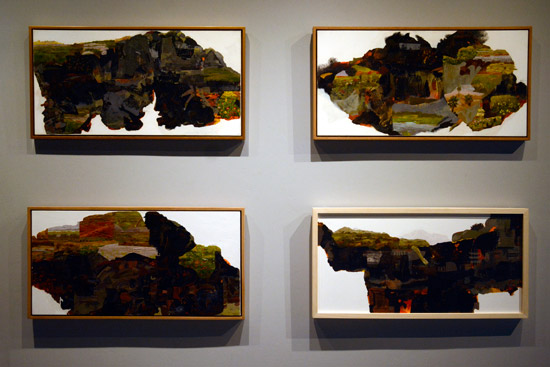Rethinking our connections with the land
The Museum of Modern and Contemporary Art Sri Lanka (MMCA
Sri Lanka) opened its doors to its newest exhibition titled ‘Total Landscaping’ on Thursday, September 12, bringing together 29 contemporary artists whose works go beyond traditional depictions of landscapes.

Thinal Sajeewa
The exhibition, curated by Sandev Handy and Thinal Sajeewa, sheds light on the ways in which land has been transformed in Sri Lanka, presenting a series of evolving exhibits that prompt a comprehensive rethinking of our connections with the land. “This is not a new conversation by any means; rather, this exhibition identifies what has long been an underlying preoccupation for contemporary artists over the past few decades. How might we understand the ways in which land has always coded the story of this nation, and conversely, how political, social, and cultural relationships have coded the land?” explains Sandev.
The first segment of the exhibition, Rotation 1, includes paintings, installations, film, drawings and photography. The exhibition also features the works of three artists, commissioned as part of ‘Arts 4 ADR’, the MMCA Sri Lanka’s collaboration with Supporting Effective Dispute Resolution (SEDR). The project aimed to increase awareness and understanding of community-based Alternative Dispute Resolution mechanisms and facilitate dialogue about the root causes of community-based conflict and disputes, focusing on the contentious issue of land politics in the Northern, Eastern and Uva provinces.

Sandev Handy
Danushka Marasinghe’s site-specific living installation of transplanted rice paddy accompanied by a serene soundscape with a hidden layer of troubling sounds sets the tone for the exhibit. This display emphasises the importance of walking and listening closely to a seemingly peaceful landscape that may have hints of threats concealed within, inviting the audience to challenge the known narratives about a particular place.
Anomaa Rajakaruna’s film, one of the commissioned exhibits, explores how we listen to, understand, and navigate the landscape, focusing on her study of Ampara, a district created in 1961 from the dry zone of Batticaloa. The Gal Oya project was part of post-independence irrigation efforts to transform the dry land into farmland with accompanying resettlements disregarding existing farming, grazing, and fishing sites, leading to the displacement of communities. “Anomaa is really interested in the ways in which all of these conflicts and reorienting of land because of the Gal Oya project have led to a kind of re-coding of how people react and relate to the land,” says Sandev.
Photographic exhibits include a series of aerial photographs by Dominic Sansoni and Sebastian Posingis that capture the island’s breathtaking landscapes, including the multi-coloured salterns of Hambantota. Complex, three-dimensional landscapes are flattened into abstract images, prompting reflection on how we frame and perceive land.
Stephen Champion provokes thought with a photograph of pine trees covering the top of a mountain range in central Sri Lanka with a forest of endemic trees climbing up its side – visual evidence of the environmental challenges faced when a foreign species occupies a landscape, destroying what is native.
One exhibit includes the works of multi-disciplinary artist Pradeep Thalawatta, whose series of paintings of the ruins of the Kankesanthurai cement factory, once a major cement exporter later abandoned due to the civil conflict, symbolise the industrial rise and fall and echo similar stories of decline in the region. Chandraguptha Thenuwara’s exhibit which features a grid of yellow and grey cement bricks commonly seen paving Colombo’s sidewalks, draws attention to the beautification process of the city following the end of the civil war, a process that reshaped the narrative of a landscape that had seen many violent turning points. This installation underscores the importance of evaluating how landscapes and their histories are intertwined and, therefore, must be remembered.

Fragmented views: An exhibit from Total Landscaping. Pix by Priyanka Samaraweera
Also on display during Rotation 1 are works by Arulraj Ulganathan, Barbara Sansoni, Hanusha Somasundaram, Jagath Weerasinghe, Jasmine Nilani Joseph, Suntharam Anojan, Thavarasa Thajendran, and Thisath Thoradeniya.
With free public programmes and outreach activities in Sinhala, English, and Tamil, aimed at students of schools and higher education institutions, MMCA’s programmes include specially curated gallery talks, workshops, reading groups, performances, artwork spotlight, curator’s tours and visitor educator tours.
‘Rotation 1 of ‘Total Landscaping’ is open to the public until December 1. Entry to the exhibition is free. The museum is on the ground floor of Crescat Boulevard, Colombo 03.
For more information, see: www.mmca-srilanka.org, Facebook at facebook.com/mmcasrilanka and Instagram at instagram.com/mmcasrilanka/.
Searching for an ideal partner? Find your soul mate on Hitad.lk, Sri Lanka's favourite marriage proposals page. With Hitad.lk matrimonial advertisements you have access to thousands of ads from potential suitors who are looking for someone just like you.


